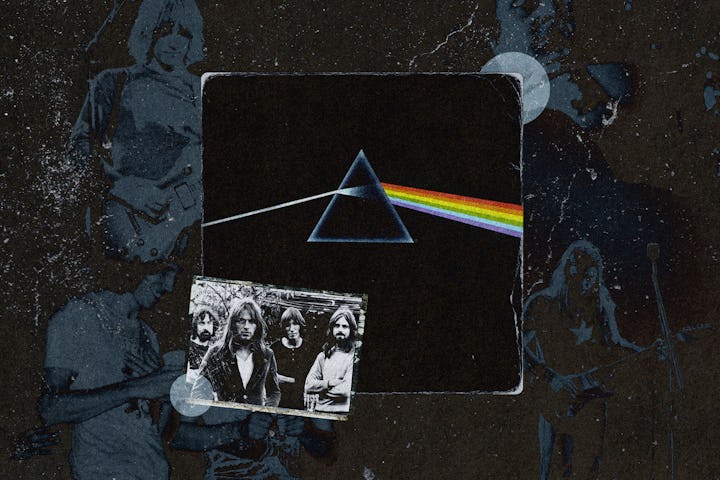50 Years Ago, One Flawless Rock Album Changed Everything
Why Pink Floyd’s The Dark Side of the Moon endures.

The beating heart of Pink Floyd’s remarkable career remains The Dark Side of the Moon. Released on March 1, 1973, this album catapulted Richard Wright, David Gilmour, Roger Waters, and Nick Mason to true international superstardom after having released seven previous progressive rock albums. That’s right, Pink Floyd was so good, that their most famous album was released almost 10 years after they formed. It remains one of music’s most influential albums — and also one of the top-sellers of all time (at 50 million copies and counting). Let’s put Dark Side on the turntable for a lookback spin, at 33 1/3, of course.
Released on March 1, 1973, in the United States, and a few weeks later in the U.K., Dark Side of the Moon consists of 10 songs spread across 43 minutes. Despite its reputation, it’s not quite a concept album, though its tracks explore aspects of life familiar to us all: birth, fear, money, greed, mental health, mortality, and more. Highlights include the tense, even paranoid instrumental “On the Run;” the lush “Breathe (In the Air),” with its gorgeous harmonies; the powerful “The Great Gig in the Sky,” which is bolstered by guest vocalist Clare Torry’s stunning contributions; the catchy anti-consumerism number, “Money;” the elegiac, “Us and Them” (“And in the end, it’s only round and round.”), and “Brain Damage,” which acknowledges former bandmate Syd Barrett’s mental issues (“There’s someone in my head but it’s not me.”).
Believe it or not, Dark Side only spent a single week at No. 1 on the Billboard 200 chart, but quite legendarily, it remained on that very same chart for nearly 1,000 nonconsecutive weeks — taking it into early 1990.
Dark Side of the Moon’s Iconic Cover
The Dark Side of the Moon
Is there a better album cover than the one created for The Dark Side of the Moon? It’s among the greatest of all time, in large part thanks to its simplicity. Against a black backdrop, a thin white beam of light enters a triangular prism and emerges rainbow-like (red, orange, yellow, green, blue, and purple, in descending order). The image is mirrored on the back of the album. And that’s it: a simple thing of beauty that can be interpreted in so many ways. Are we the light? Are we experiencing life, and entering infinity? Graphic designer Storm Thorgerson (in collaboration with Aubrey Powell) created the cover via their company, Hipgnosis. Thorgerson also created the iconic covers for Peter Gabriel III (the melting face), Led Zeppelin’s In Through the Out Door, Wings’ Band on the Run, as well as most of Pink Floyd’s albums, including Meddle and Animals.
The Beginning of the End for Pink Floyd
Pink Floyd on tour in March 1973.
Dark Side of the Moon sent Pink Floyd into orbit. The band became something resembling a machine, crafting subsequent albums — notably The Wall — and touring intensively but growing apart in the process. Waters nudged Wright to leave, and it became Waters, the other guys, and session musicians. These days, Waters even downplays the contributions of his fellow bandmates and engineer Alan Parsons, who weaved some mighty sonic magic at the mixing boards. Pink Floyd never again felt this cohesive as a band, nor did any subsequent album hang together as cohesively as Dark Side of the Moon. Some fans might make the case for The Wall, but it grows ponderous and is too long by several songs.
Children of The Dark Side
Roger Waters in May 1973.
It’s easy to name bands and performers influenced by The Dark Side of the Moon. Look no further than Radiohead, The Flaming Lips, Tame Impala, Tool, and early Coldplay, not to mention the many, many Pink Floyd cover band that have earned their money playing “Money.” But the influence of Dark Side extends far beyond that (or any tribute albums, collectors’ editions, etc.). It’s very likely that you’ve worn, or still wear, a Dark Side T-shirt. Your kid might, too.
Hell, people who’ve never listened to a note on the album recognized its cover, or have heard about the supposed connections to The Wizard of Oz. Also, back in 2020, the Dark Side track “Eclipse” saw new life thanks to its use in the first trailer for Dune: Part One, in which the song briefly became the soundtrack for the journey of Paul Atreides (Timothée Chalamet).
And then there are the light shows. Raise your hand if you saw a Dark Side of the Moon laser show at your local planetarium. Pink Floyd actually launched the album at the London Planetarium and this year more than 100 planetariums will offer a state-of-the-art production synced to Dark Side of the Moon. Also on the way: a deluxe box set, a book (with photos from the Dark Side tour in 1973-74), and more.
Any way you slice it, The Dark Side of the Moon remains as vital — and psychedelic, inventive, cool, and occasionally grandiose — as ever.
This article was originally published on